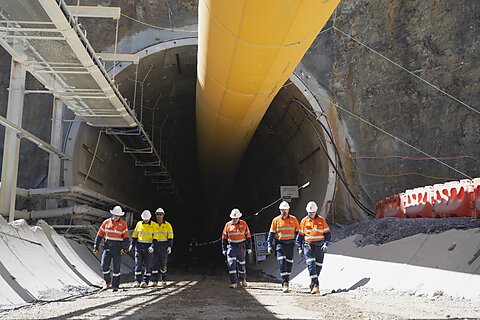Chris Edwards and Krit Chanwong
Government infrastructure projects often go far over budget. Around the world, the costs of transit systems, energy developments, and other projects frequently soar above what was promised. One cause is the low‐balling of initial cost projections to help secure public support.
A massive Australian energy project is an exemplar of runaway costs. The budget of the Snowy 2.0 power dam and energy storage project has exploded from $2 billion in 2017 to $12 billion today. The project is a reminder that taxpayers should be skeptical when governments propose large and complex construction schemes.
In the 1970s, Australia completed a system of 16 dams, seven power stations, and miles of tunnels called the Snowy Scheme. The project produces electricity and provides water for irrigated farming. It took 25 years to complete and cost $820 million, or about $8 billion in today’s Australian dollars.
In 2017, the Australian government announced Snowy 2.0, which will add tunnels, generation capacity, and large‐scale power storage to the Snowy Scheme. Once completed, Snowy 2.0 is supposed to “provide an additional 2,200 megawatts of dispatchable, on‐demand generating capacity and approximately 350,000 megawatt hours of large‐scale storage to the National Electricity Market.”
The energy storage plan is to pump water uphill in periods of excess supply and then use the water to generate power when other supply sources—such as solar and wind—ebb. The project was “sold as a nation‐building project for a low‐carbon future.”
When Snowy 2.0 was announced in 2017, the government claimed it would cost $2 billion and be open in 2024. Government‐owned Snowy Hydro pushed for approval saying it had completed “two years of rigorous due diligence.” But some experts warned at the time that the cost estimates were low‐balled.
Over the years, the project has suffered major technical difficulties and delays. One of the project’s large tunneling machines advanced much slower than planned, created a giant sinkhole, and got stuck in soft ground for months.
Snowy Hydro announced in August 2023 that 2.0 would now cost $12 billion and be completed no earlier than 2028. If we add the costs needed to connect 2.0’s generation to the grid, the total cost could be $20 billion. An Australian dollar is about 65 cents of a US dollar.
Government dam projects are particularly prone to cost overruns. A 2014 study of 245 large dam projects found, “Large dams built in every region of the world suffer systematic cost overruns,” and the final costs of the sample projects “were on average 96% higher than estimated costs.” Snowy 2.0’s cost overrun of at least 500 percent is an extreme case but fits a common pattern.
Experts have questioned other aspects of Snowy 2.0 in addition to the soaring costs. Pumping water uphill for storage requires electric power from other sources, which in Australia includes large amounts of coal‐fueled power. In the near term, Snowy 2.0 may increase the demand for coal‐fueled power. Also, Snowy 2.0 will account for just a tiny fraction of Australia’s energy storage needs if the country were to fully transition to renewables. Furthermore, building vast infrastructure in a forest and re‐plumbing river systems is not green. Finally, Australian regulators have sounded the alarm over Snowy’s monopoly power and rising electricity prices.
This critique of Snowy 2.0 focuses on the problems of large‐scale energy projects. American policymakers would do well to heed the conclusion: “Given the pace of change, it would seem sensible to make the most of cheaper solutions which can be built quickly and don’t lock us in or out to technologies for the long term.”



























